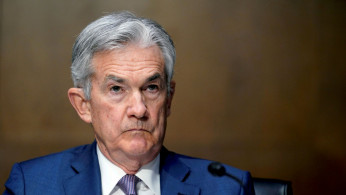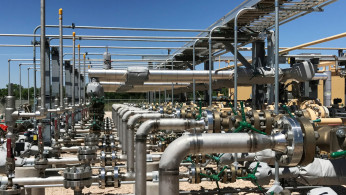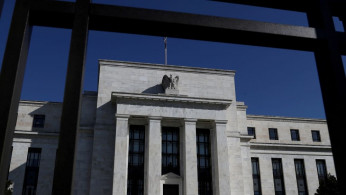Jerry Lin

The Latest
-
Fed Signals Rate Cuts Ahead as Inflation Cools: Powell Says ‘The Time Has Come for Policy to Adjust’
Federal Reserve Chair Jerome Powell hinted at imminent interest rate cuts during his keynote address at the Fed's annual retreat in Jackson Hole, Wyoming. While Powell refrained from specifying the exact timing or magnitude of the cuts, his message was clear: the central bank is ready to shift its focus after a prolonged period of aggressive rate hikes aimed at taming inflation. 
Federal Reserve Chair Jerome Powell hinted at imminent interest rate cuts during his keynote address at the Fed's annual retreat in Jackson Hole, Wyoming. While Powell refrained from specifying the exact timing or magnitude of the cuts, his message was clear: the central bank is ready to shift its focus after a prolonged period of aggressive rate hikes aimed at taming inflation. -
Jobless Claims Edge Up, But Labor Market Remains Robust Amid Fed's Rate Hike Concerns
The U.S. job market continues to show signs of resilience, even as the number of Americans filing for unemployment benefits rose modestly last week. According to the latest data from the Department of Labor, jobless claims increased by 4,000 to a seasonally adjusted 232,000 for the week ending August 17. Despite this uptick, the level of claims remains historically low, reflecting a labor market that is cooling gradually but still healthy. 
The U.S. job market continues to show signs of resilience, even as the number of Americans filing for unemployment benefits rose modestly last week. According to the latest data from the Department of Labor, jobless claims increased by 4,000 to a seasonally adjusted 232,000 for the week ending August 17. Despite this uptick, the level of claims remains historically low, reflecting a labor market that is cooling gradually but still healthy. -
Oil Prices Steady After Four-Day Slide Amid Concerns Over Global Demand Outlook
Oil prices stabilized on Thursday following four consecutive days of decline as concerns over global demand weighed heavily on the market. Despite these worries, a significant drawdown in U.S. crude oil inventories provided a much-needed floor for prices. 
Oil prices stabilized on Thursday following four consecutive days of decline as concerns over global demand weighed heavily on the market. Despite these worries, a significant drawdown in U.S. crude oil inventories provided a much-needed floor for prices. -
Fed Signals September Rate Cut Likely as Economic Concerns Mount
Federal Reserve officials are increasingly inclined toward a much-anticipated interest rate cut in September, according to minutes released from their July meeting. The meeting, which took place on July 30-31, revealed that while the central bank held rates steady, there was considerable support for a rate reduction at their next policy gathering. 
Federal Reserve officials are increasingly inclined toward a much-anticipated interest rate cut in September, according to minutes released from their July meeting. The meeting, which took place on July 30-31, revealed that while the central bank held rates steady, there was considerable support for a rate reduction at their next policy gathering. -
U.S. Job Market Weaker Than Reported: Labor Department Revises Payroll Growth Down by 818,000
The Labor Department announced on Wednesday that the U.S. economy created 818,000 fewer jobs than originally reported over the 12-month period ending in March 2024. The Bureau of Labor Statistics (BLS), as part of its annual benchmark revisions, indicated that actual job growth during this period was nearly 30% lower than the initially reported 2.9 million jobs. 
The Labor Department announced on Wednesday that the U.S. economy created 818,000 fewer jobs than originally reported over the 12-month period ending in March 2024. The Bureau of Labor Statistics (BLS), as part of its annual benchmark revisions, indicated that actual job growth during this period was nearly 30% lower than the initially reported 2.9 million jobs. -
Gold Prices Retreat Ahead of Fed Minutes as Investors Await Clarity on Interest Rates
Gold prices edged lower on Wednesday as the dollar regained its footing after a period of decline, with investors shifting their focus to the upcoming minutes from the U.S. Federal Reserve's most recent policy meeting. The precious metal, which had surged to a record high earlier in the week, saw some profit-taking as traders awaited signals on the future of U.S. interest rates. 
Gold prices edged lower on Wednesday as the dollar regained its footing after a period of decline, with investors shifting their focus to the upcoming minutes from the U.S. Federal Reserve's most recent policy meeting. The precious metal, which had surged to a record high earlier in the week, saw some profit-taking as traders awaited signals on the future of U.S. interest rates. -
Oil Prices Rebound as Traders Eye U.S. Stockpile Data Amid Middle East Tensions
Oil prices experienced a modest recovery on Wednesday, edging higher after several consecutive days of losses driven by concerns over weakening Chinese demand and diminishing fears that the conflict in the Middle East could escalate to disrupt supply chains. Brent crude futures saw a rise of 47 cents, or 0.6%, reaching $77.67 a barrel, while U.S. West Texas Intermediate (WTI) crude gained 48 cents, or 0.7%, to settle at $73.65 per barrel. 
Oil prices experienced a modest recovery on Wednesday, edging higher after several consecutive days of losses driven by concerns over weakening Chinese demand and diminishing fears that the conflict in the Middle East could escalate to disrupt supply chains. Brent crude futures saw a rise of 47 cents, or 0.6%, reaching $77.67 a barrel, while U.S. West Texas Intermediate (WTI) crude gained 48 cents, or 0.7%, to settle at $73.65 per barrel. -
Australia’s Central Bank Signals Prolonged High Rates Amid Inflation Concerns
Australia's central bank has indicated that interest rates will likely remain at their current 12-year high for an "extended period," signaling that a rate cut is unlikely in the near term as policymakers continue their fight against inflation. This stance was revealed in the minutes from the Reserve Bank of Australia's (RBA) August 5-6 meeting, which emphasized the need for sustained restrictive monetary policy to ensure inflation returns to its target range of 2-3%. 
Australia's central bank has indicated that interest rates will likely remain at their current 12-year high for an "extended period," signaling that a rate cut is unlikely in the near term as policymakers continue their fight against inflation. This stance was revealed in the minutes from the Reserve Bank of Australia's (RBA) August 5-6 meeting, which emphasized the need for sustained restrictive monetary policy to ensure inflation returns to its target range of 2-3%. -
Gold Soars to Record High as Investors Eye Fed Rate Cuts
Gold prices surged to a record high on Tuesday, as increasing expectations of interest rate cuts from the U.S. Federal Reserve prompted a wave of investment in the precious metal. The spot price of gold rose to $2,528.53 per ounce, marking a nearly 1% gain for the day and setting a new all-time high. This rise reflects a broader trend where investors, wary of economic uncertainty and geopolitical tensions, are turning to gold as a safe haven. 
Gold prices surged to a record high on Tuesday, as increasing expectations of interest rate cuts from the U.S. Federal Reserve prompted a wave of investment in the precious metal. The spot price of gold rose to $2,528.53 per ounce, marking a nearly 1% gain for the day and setting a new all-time high. This rise reflects a broader trend where investors, wary of economic uncertainty and geopolitical tensions, are turning to gold as a safe haven. -
Bitcoin Tops $61K with Eyes on Federal Reserve’s Upcoming Rate Decision
Bitcoin prices climbed above $61,000 in early European trading on Tuesday, marking a significant recovery after two consecutive sessions of losses. Despite this rise, the market remains volatile, with the Bitcoin Volatility Index hovering near its yearly high of 3.07%. 
Bitcoin prices climbed above $61,000 in early European trading on Tuesday, marking a significant recovery after two consecutive sessions of losses. Despite this rise, the market remains volatile, with the Bitcoin Volatility Index hovering near its yearly high of 3.07%.